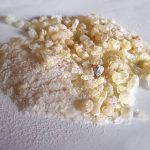 Dammar is the resin of deciduous trees from the family of the wing crops that grow in India and on the Sunda Islands in the Malay Archipelago. Dammar is also produced in Indonesia, Papua New Guinea and the Philippines. The tree Shorea wiesneri is considered the most important source, but the resin is also obtained from many other Shorea, Hopea, and Vatica species as well as Neobalanocarpus heimii. The colors of the different varieties vary from clear-light, yellowish to the black-gray Sumatra-Dammar. The white dammar is the resin of the Indian species Vateria indica, black dammar comes from Canarium strictum from the balsam family. The so-called Harte Dammar, another name of the Kauri resin (New Zealand Dammar), is the resin of the New Zealand Kauri spruce (araucariae), a conifer that is also extracted from fossil deposits as a much harder copal. The hardness of the Dammar resin is similar to that of rosin, it is less hard and durable than Copal. The resin is slightly sticky and, when broken, is mussel-like and shiny glass. The scent is fine lemon and light. Grated, a white powder results that has an aromatic bitter taste. The name Dammar comes from the Malay and means tear, resin tear, resin or light, torch. (From Wikipedia)
Dammar is the resin of deciduous trees from the family of the wing crops that grow in India and on the Sunda Islands in the Malay Archipelago. Dammar is also produced in Indonesia, Papua New Guinea and the Philippines. The tree Shorea wiesneri is considered the most important source, but the resin is also obtained from many other Shorea, Hopea, and Vatica species as well as Neobalanocarpus heimii. The colors of the different varieties vary from clear-light, yellowish to the black-gray Sumatra-Dammar. The white dammar is the resin of the Indian species Vateria indica, black dammar comes from Canarium strictum from the balsam family. The so-called Harte Dammar, another name of the Kauri resin (New Zealand Dammar), is the resin of the New Zealand Kauri spruce (araucariae), a conifer that is also extracted from fossil deposits as a much harder copal. The hardness of the Dammar resin is similar to that of rosin, it is less hard and durable than Copal. The resin is slightly sticky and, when broken, is mussel-like and shiny glass. The scent is fine lemon and light. Grated, a white powder results that has an aromatic bitter taste. The name Dammar comes from the Malay and means tear, resin tear, resin or light, torch. (From Wikipedia)

 Deutsch
Deutsch